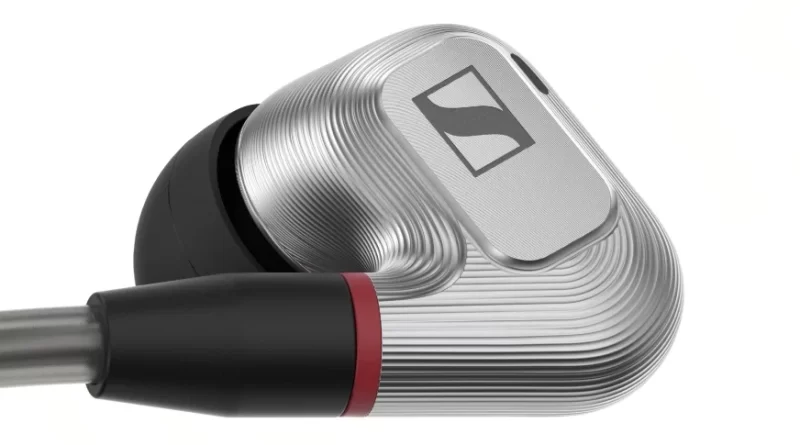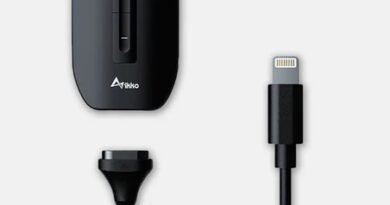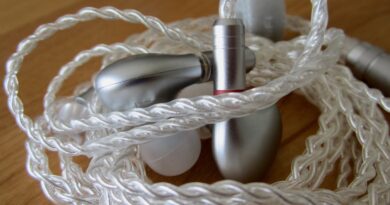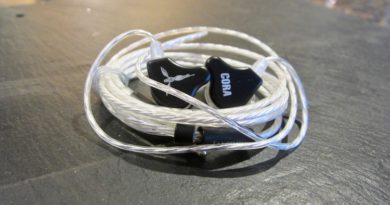Sennheiser IE900 Review (1) – Classical Reinvented
It sadly took me much longer than I initially planned to put together this article about one of the most outstanding IEM sets I ever happened to audition. Also due to some unpleasant health problems which still partly grip me, it is only now that I am able to publish my piece about the IE900s demo unit I received from Sennheiser Europe no later than last August 🙁 .
I can anticipate I had a very big pleasure in the encounter, and I hope I’ll be able to properly convey my take on the many pluses and few minuses of this set, together with some comparison hints with their lower cost (but not lower quality) sisters IE600 and more.
IE900 currently sell in Europe for € 1499.00 including VAT. Main official product page, with direct purchase possibility here.
In this Article
At-a-glance Card
| PROs | CONs |
| Out-of-the-choir tonality tuning yielding exquisite results on classical and most other acoustic music | Arguably not an “all-rounder” tuning |
| Class-leading bilateral range extension | Lean-ish high mids and female vocals |
| Arguably best DD on the market now at the technological level | Some may occasionally like more sub-bass volume |
| Spectacular multifaceted treble management | Thin housing structure may not perfectly fit everyone’s ears |
| Clean yet very emotional bass | Stock tips (silicon in particular) may not fit everyone’s needs |
| Deep reaching sub-bass delivering measured rumble floor | Proprietary “MMCX Fidelity+” connectors not compatible with mainstream third party cables |
| Breath-taking technicalities: “infinite layers”, wonderful microdynamics | |
| Very extended stage, on par with closedback over ears | |
| Custom Comfort Tips program (available in Germany only yet) |
Full Device Card
Test setup and preliminary notes
Sources: Questyle QP1R, QP2R, M15, CMA-400i / Lotoo Paw Gold Touch + Cayin C9 / Sony WM-1A / E1DA 9038D, 9038SG3 – INAIRS AIR1 foam and/or JVC SpiralDot silicon tips – Stock cable – lossless 16-24/44.1-192 FLAC + DSD 64/128/256 tracks.
I am not writing these articles to help manufacturers promote their products, even less I’m expecting or even accepting compensation when I do. I’m writing exclusively to share my fun – and sometimes my disappointment – about gear that I happen to buy, borrow or somehow receive for audition.
Another crucial fact to note is that I have very sided and circumscribed musical tastes: I almost exclusively listen to jazz, and even more particularly to the strains of post bop, modal, hard bop and avantgarde which developed from the late ’50ies to the late ’70ies. In audio-related terms this implies that I mostly listen to musical situations featuring small or even very small groups playing acoustic instruments, on not big stages.
One of the first direct consequences of the above is that you should not expect me to provide broad information about how a certain product fares with many different musical genres. Oppositely, you should always keep in mind that – different gear treating digital and analog sound in different ways – my evaluations may not, in full or in part, be applicable to your preferred musical genre.
Another consequence is that I build my digital library by painstakingly cherry-pick editions offering the least possible compression and pumped loudness, and the most extended dynamic range. This alone, by the way, makes common music streaming services pretty much useless for me, as they offer almost exclusively the polar opposite. And, again by the way, quite a few of the editions in my library are monoaural.
Additionally: my library includes a significant number of unedited, very high sample rate re-digitisations of vinyl or open-reel tape editions, either dating back to the original day or more recently reissued under specialised labels e.g. Blue Note Tone Poet, Music Matters, Esoteric Jp, Analogue Productions, Impulse! Originals, and such. Oppositely, I could ever find an extremely small number of audible (for my preferences) SACD editions.
My source gear is correspondigly selected to grant very extended bandwidth, high reconstruction proweness, uncolored amping.
And finally, my preferred drivers (ear or headphones) are first and foremost supposed to feature solid note-body timbre, and an as magically centered compromise between fine detail, articulated texturing and microdynamics as their designers can possibly achieve.
In terms of presentation, for IEMs I prefer one in the shape of a DF curve, with some very moderate extra pushup in the midbass. Extra sub-bass enhancement is totally optional, and solely welcome if seriously well controlled. Last octave treble is also welcome from whomever is really able to turn that into further spatial drawing upgrade, all others please abstain.
Signature analysis
Tonality
IE900’s general tonality is bright-neutral. The timbre is slightly lean, especially in the mids, and you can tell from the very first audition that this is a product aimed at rendering trebles in the most organic, detailed, engaging at the same time non-distorting way as possible, while in the process never leaving bass less attended to. And – boy! – if they succeeded at this!
From a more tech-involved angle standpoint, what I also very interesting to note is that they chose not to closely follow, let alone chase, any most en vague target curves out there… More on this, maybe, much later on.
Sub-Bass
One of Sennheiser’s 7mm dynamic driver’s qualities – perhaps not the most important one, but the most readily apparent to me for sure – is its extension capabilities, something very hardly heard before on IEMs, at least from my modest hobbyist’s ears.
As a direct consequence of that bass reaches as deeeep as you can possibly hear. You can safely bet the limiting factor in this case is more your hearing than anything else.
In terms of volume some elevation is present, but a modest one at that. IE900 definitely are not made to satisfy so-called bassheads, not even “educated” ones. Even for the tastes of die hard acoustic jazz lovers like me, there are times when I concede to the pulsion to adding a +3dB low shelf at 50 Hz, but that’s really occasional: in most situations IE900 sub bass is just perfect for my (quite specialised – mind you!) library.
I’ll reach even further, actually, and I would say that although not so high in elevation it’s presence is anyhow so consistent and predictable that the net effect is similar to adding a subwoofer to your nearfield setup, keeping it at a modest sound pressure level, just for “background support”, so to say.
Mid Bass
IE900’s mid bass is fast, even sculpted, yet fully textured and very expressive, emotional. This is one of the sets that renders Andrew Cyrille’s kick drum with the highest level of realism I ever auditioned.
This weren’t enough IE900, and very particularly its bass line, scale incredibly well with amping power and quality.
While in general IE900’s sensitivity is not low, so as to make them driveable to already outstanding results by relatively modest powered mobile sources, you will be totally astonished by the difference – emerging particularly in the bass section – when driving them from high quality, much higher specced amp sources.
One inter alia: Cayin C9, which I happen to have access to. Mid bass and low bass notes come up in body, viscerality and slam in a totally surprising way. It all sounds (pun intended) as if you’re sitting in a mixing studios listening to on those high end monitors hanging in there. Really, really, REALLY significant. Oh and by the way: even in such “exalted” situation, mid bass never, ever takes over on the low mids…!
Mids
Mids feel slightly recessed, if nothing else because the other parts around them (bass, and most of all high mids and trebles) come across with even bolder personality, so to say.
On the other hand their general timbre is very good if a bit lean especially in the high part, yet feels spot-on in most if not really all cases for my library.
The passage from middle to high mids easily reminds me what happens on Final’s A3000 – another, much lower tier, single-DD set featuring a remarkable (within its price class) quality single dynamic driver. And, another virtuous example of totally surprising results based on a not so common, off-choir even, tuning curve.
The passage is very smooth, of course consequence of the one driver employed, and also of the sensible taming applied to the 2-4Khz region which, thanks to driver elasticity (and, in IE900’s case, of who knows what other aspects liaised to the triple resonance chamber milled into their housings – more on this below), does not translate into overly tamed feedback in that region, oppositely it delivers a very lively, detailed while unoffensive experience.
As I mentioned before, if one remark the high mids segment calls for is some relative leanness to the notes. I feel some “butter” missing on central piano octaves, and on female vocals, to match my personal perfection. I’m not of course expecting to find the same focus on that region here that you can get from specialised sets like Final F7200 to just name one, yet as I said just a tad more of lipids would have rendered the dish even more flavoury.
Male Vocals
IE900 render baritones and bass humans with organicity and authority, and tenors, too, with just a bit of relative leanness commencing to appear on their higher registers.
Female Vocals
Female vocals are well presented, textured, clean and quite engaging. As mentioned above, they do lack a bit of body to their central notes to be astonishing.
Highs
These, together with some of the technicalities, are evidently the stars of the show on IE900.
The result is so outstanding that you can bet this must be the consequence of something really special the developers had to put in to get there: energy, expression, body, details and air, all together, while never scanting into sibilance, shoutyness let alone zinging.
A wonderful litmus paper test for this is Lee Morgan’s trumpet phrasings from 1 up to to 2 minutes into Art Blakey’s & The Messenger’s monumental 1958 Moanin’ take, from the homonymous album. Morgan instrument’s sound is full bodied yet perfectly textured, but most of all powerful yet not piercing, and far from splashy or shouty.
Such result does vary a bit in accuracy depending on eartips selection (more on this below).
Incidentally, I could only hear one other set doing better to date, but it did so only on this very particular aspect and failed in others in comparison to IE900, bass being first: a German-made multidriver unit. Oh and that’s priced 3X over our today’s reference 😉 .
Technicalities
Soundstage
IE900 stage projection is probably the widest I ever heard in an IEM, and while I think about that I would also put all closed-back overears I heard in, for good measure. There’s significant height and good depth, too !
This is another situation where IE900’s huge treble extension shows its good deeds: as many know of course we can hear sounds up to 16Khz (well… when young! 🙂 ) but frequencies above such mark are not useless at all, as they contribute carrying information about the time it takes for sound to come back (or not come back) from the “walls around the room” – thereby helping on “drawing the stage”.
This is of course only evident when the source digital material does contain such higher frequency information, and the DAC is indeed capable of reconstructing it – which is luckily the case for much of my library, and a few of my sources 😉 .
Imaging
Macrodynamics are extremely precise, positioning cues are spot on at all times, along all 3 axes.
Details
Detail retrieval from the high mids and especially from the treble is nothing short than superb, twice as much if again we remember we are in presence of a single DD set.
I like to believe this is one consequence of those Sennheiser’s claimed designs efforts focused on sound modelling obtained via those cavities inside the housings (more on this below).
Let me add that, as an old western-economy industry bear myself, I also like to think that in addition to the positivity on the obtained result this way of proceeding is also much less prone to be “easily replied” by of some of those chifi usual suspects – building practical reproduction hurdles into one’s physical product arguably representing an even more effective method, supplemental to “mere” legal patenting, to better protect one’s industrial invention efforts in our globalised world lacking cohesive governance.
Instrument separation
Layering and instrument separation is another field where IE900 surely excel, once again especially so when considering we are talking about a single driver set.
Even on busiest (acoustic) tracks you never get a sense of congestion or mixture between voicings coming from the same spot on the stage, and the sense of depth is always granted. At times, it seems as if IE900 are able to render virtually infinite layers, such is their capability in keeping overlapping but heterogenous sounds apart from one another.
I could only hear one other IEM set till now able – on equal source gear and tracks, of course – to present me with a superior readability on low volume and/or background sounds, and that’s Softears Turii – which other technicalities, and the tonality before them, are however quite different from IE900’s so I wouldn’t easily cast a better/worse score between the two, frankly.
Driveability
As en passant I previously mentioned, IE900 are quite easy to drive exploiting the power of so many at least decent mobile sources on the mainstream market, most dongles included. Their 123dB/V (corresponding to approx 105dB/mW) at 18 ohm are not a huge requirement in facts, and that’s surely a big plus in terms of crowd accessibility.
On the other hand, IE900’s note body will dramatically improve when the source happens to have the guts to push up on current delivery, this with particular regards to mid bass and mid tones.
While listening to IE900 directly paired to a Lotoo Paw Gold Touch DAP is already a lushy treat – for many reasons, first and foremost LPGT’s quite special proweness on subtle microdynamics reconstruction – you should wait until you’ll hear what you get having LPGT’s output pass through a further amplification stage, e.g. a Cayin C9 mobile set: then you’ll be in for a strong experience … 🙂 .
Such situation can, and should, be reported both as a pro and as a (relative) limitation of the set.
Physicals
Build
I suspect not to be the only one whose first eye-impression when shown a pair of IE900 has been something like: “inconspicuous”.
Actually handling them such impression – well, at least my impression – changed radically: IE900’s housing are in facts CNC-milled off a solid piece of aluminium, which incidentally is a wonderful material I happen to know the positive properties of due to my professional involvement with it, on a completely different market.
Long story short, IE900’s housings are at the same time extremely solid and sturdy, and very lightweight.
I also do approve the choice for those thin engraving lines on the outside, which – if anything on the aesthetical level – result in a pleasant, if a bit mitteleuropean-industry-flavoured, “unglossy” finish style, and avoid overexposure to fingerprinting.
On the solidity and shock resistance there’s no question: a solid piece of aluminium gives more than the required warranties for this use case. I’m ready to bet that trampling over these ones (with their cable removed) with a car would leave them a bit dirty, but in shape.
Apart from all this, what is surely most interesting is what cannot be appreciated from the outside, and that is the internal shaping given to the housings – always by CNC-milling them – and the specially developed ultrawide range-capable 7mm dynamic driver.
The DD is responsible for offering coverage for an exceptionally wide range of frequencies for a single driver: from 5 to 48KHz.
That being not enough, taken alone, to deliver the wanted sonic result, tonality shaping is carried out by way of tree small resonator chambers, i.e. appropriate “carvings” milled into the very piece of solid AL making the housings, in-between the driver and the nozzle. Furthermore, some specialty shaping and internal surfaces finishing is put in there, to take care of smoothening excessive treble energy – and I must say with excellent results, based on my audition (see above).
Fit
Kudos to Sennheiser also for the just incredibly effective ergonomics they conceived for the shape of their IE series, which includes IE900 of course.
Even if for some reason you wouldn’t tell when seeing that somehow uncommon form for the first time, it takes seconds after wearing (any of) them the first time to vibrantly love them, and the one(s) who designed them.
On the flip – read negative – side two things are worth noting.
One: in some cases – me included – the main housing body may be a (decisive) tad too lean to match those magical proportions which fill your outer ear just enough to gain perfectly stable positioning while never feel like a swollen bean is nagging at you from out there.
It’s of course then evident that you can’t possibly design a one-size solid structure that’s so precisely fitting into everybody’s body, no matter human diversity. And in doubt, of course you’ll have to do it smaller vs bigger ! So this ain’t defect of course, yet it’s definitely an issue to manage, when it arises.
Two: again, in my case, the supply of stock tips (both silicon and foam) for one reason or the other falls short of being adequate.
Stock silicon tips have a very soft umbrella, 100% studied to get the best intended sound out of the IE900. Too bad that on the “mechanical” front it happens that, housings being too lean to stay put in my concha’s, I instinctually tend to regain firmness by pushing them deeper in. When that happens silicon tips’ umbrellas fold on themselves, totally losing the seal.
Sadly, the problem about stock tips falling short of properly fitting my canals (left one in particular) affects foamies too! Again, I suspect that’s liaised with me needing to get a higher stability by pushing shells deeper in, thereby reaching a wider segment of my ear canal, which those foamies can’t adequately fill up, not even the supplied L size.
I shared this issue with Sennheiser, and the answer has been enlightening for the sake of clarifying the origins of this situation.
First and foremost, in Sennheiser’s design intention IE900 tips should ideally “feel as if they disappear” in the ear canal, precisely the opposite of the sensation you get from bullet style IEMs, and/or triple-flanged eartips. Hence, the thinner umbrella the better, of course.
Flipping the coin, however, superlight tips intended for such precise aim will not be the best choice if for whatever reason a user prefers, or needs, to achieve a deeper fit.
I do confirm all : if – disregarding stability for a moment – I wear IE900 in a shallower position, indeed their stock silicon tips do keep the seal, and they deliver a very pleasant “feathery” sensation, or even virtually no sensation at all – as per intention.
And by the way, were it possible and handy for me, I would actually prefer such shallow fit, not being myself a die-hard fan of deep insertion – even when I use bullet-shape IEMs (which nevertheless – Sennheiser friends will forgive me – I don’t find so devilish counter-ergonomic as they reckon).
Be as it may, this finally reveals what the entire real problem is in my case: housings’ stability.
Again, in Sennheiser’s design intention, in cases like mine where the person’s ear structure is a bit too big and can’t grab the housings firm by itself, that’s where those easy-shape earhook sheaths installed on the cable (more on them below, under “Cable”) should do the trick, mechanically retrofitting the set so to say, and delivering the required stability.
So that is precisely where the game fails in my case (and not my one only).
No, to me those shapeable earhooks are super-comfortable, but not resilient enough to compensate for the housings’ eventual wobbling. That’s why I can’t personally “afford” a shallow fit, and rest comes with it.
Curtain fall ? Nevah !
First possible workaround: browsing the internet I found some sort of third party “gel outfits” – of course made some place in China. I call them “gloves”: imagine little-finger sized equivalents to a silicon smartphone back-cover. Or, similar to those winged rings you fit onto TWS drivers to help them stay firm in place. Something like this, but there are others around too.
I tried a friend’s ones and indeed those perfectly fit IE900’s housings, granting them that small body size increment that results into fitting my ear in a perfectly stable and comfortable way. And then, yes!, I can afford shallower fit and the whole stock tips game works as per design in my case too.
Alternative workaround: use third party tips 🙂 .
Well as you can imagine I would have gone through the long tips exploration session anyhow, but in this case it was let’s say double motivated.
This article is getting already lengthy and I don’t believe that adding further smalltalk to it would make it better so my eighteen readers will I hope understand if I won’t indulge in the full report here about how I found each of the probably 15 different tip models I tried.
Suffice it to say that in the end I’m torn between two options, featuring some differences : INAIRS AIR1 foams, and JVC SpiralDot silicons.
INAIRS offer a firmer fit sensation, and their M size actually well fills my external ear canal up, thereby effectively contributing to hold those slim housings firm(er) in place for me. They also grant me better passive isolation, and a sort of delicate “softening” to some note edges (which, in itself, is not always a welcome addition).
SpiralDots feature stiffer silicon umbrellas compared to stock tips but won’t go as far as mechanically compensating housings movements, so their adoption does require either a deeper fit, or those “gel gloves” I mentioned before. The good news is that they are sturdy enough not to lose the seal when pushed deeper. Their wide bore positively contributes to IE900’s already good bass, and they yield a more crystalline timbre compared to foams.
Runnerup silicon options worth mentioning are Radius Deepmount – even better than Spiraldot on bass definition and speed, but tend to turn trebles a bit too hot – and Final E (strictly CLEAR version – black and other-coloured ones making low bass a bit “hazy”) – which deliver more body in the mids but lose some detail and precision in the treble and bass.
Last but absolutely not least, Sennheiser and their mother company being deeply involved with medical grade hearing aids and technologies, a custom eartips production service is made available – sadly only to German residents for now though 🙁 .
It’s called Custom Comfort Tips. The rationale seems very simple in its complexity: by realising an elongated silicon tip, custom shaped following your own ear canal shape and size on one end, and perfectly slapping onto the IEM’s nozzles and neighbouring shell part on the other, you get extremely close to eliminate that personal fit variation that makes each one’s sound experience with that particular driver too much “potentially different” from its intended goal.
The program is also very well streamlined in terms of enduser fruition. It’s all centrally managed by Sennheiser, you don’t have to “look for” anything your own: place the order centrally, geoloc the supporting audiologist shop nearest to your location from a link on Sennheiser’s site, take an appointment and have your canals measured there (their service is part of the price paid to Sennheiser), wait for a few days and receive your tips at home.
The very same tips can be swapped onto IE900, IE600 and IE200. The tips’ fee is currently included with the price of an IE900 package, and a discount is offered to IE600 owners.
Those friends (lucky bastards individuals) who, residing in Germany, already could get their custom tips confirm they are indeed absolute game changers. The rest of us need to come to terms with a impatient wait 🙂 .
Comfort
IE900’s shape is designed for very easy and natural fit and this immediately traduces into supreme comfort even for very protracted period of time.
In case the housing turns out to be a bit too “slim” for one’s ears (like in my case) there’s a chance the consequent instability may be somewhat fastidious. Longer story above about the origins of this. Consequences: compensating instability by reaching down for a deeper fit may turn out to be a bit uncomfy in medium/long sessions; adopting “gel gloves” of appropriate thickness may be the best way to go.
Isolation
When perfectly fitting, IE900 offer good levels of passive isolation – even more if equipped with foam tips.
In “fat concha” situations like my case, the same result is quite easily obtained by outfitting the housings with with “gel gloves” or such (see above).
Cable
It’s certainly pleasing – if after all in line with expectations vis-a-vis the package price, one may say – to find 3 different cables inside the box, each with a different hard-wired termination: single ended 3.5mm, and balanced 2.5 and 4.4mm, covering I would say 99.9% of possible needs.
Also, the freely mouldable TPU sheath applied towards to cables housing’s end allows you to shape them into the most precisely matching and comfortable earhooks you can get, exactly following your ear root line.
It’s the first time I encounter this offering, and it’s a very welcome feat – even if, as reported under “Fit” here above, it does not get as far as solving the problem of housings being too lean for my particular outer ears.
On another important note: Sennheiser’s IE-line MMCX connectors are not “everyday MMCX” fixings in reality. So be prepared: hardly any of your (my!) existing MMCX cables will fit, or safely fit 🙁 .
Sennheiser’s MMCX implementation (in some documents tagged as “MMCX Fidelity+”) is indeed proprietary. Looking closely, the male connector coming off the tip of the cable has an additional “lip” compared to ordinary MMCX plugs. Such lip, plus a deeper, and more deeply recessed female connector, are responsible for significantly improving on connection firmness.
All good so far, the less good news however being the following two.
One I already mentioned: 99% chances are that you won’t be able to pair your IE900 with any loved individual off your thick existing herd of however good – and expensive! – MMCX cables.
The other is safely identifying the genuinely licensed (!) third parties, which would therefore be in condition to supply reliably compatible cables. Fact: between a few friends of mine and myself we experienced a few 3rd party cables sold as IE900-compatible, most of which turned into wobbly, unreliable connections. Tread lightly when shopping for cables here!!
Specifications (declared)
| Housing | Precision-milled and anodized aluminium housing with internal Helmholtz resonator chambers |
| Driver(s) | 7mm XWB (eXtra Wide Band) dynamic driver featuring Sennheiser’s X3R TrueResponse transducer technology |
| Connector | Gold-plated “MMCX Fidelity+” connectors |
| Cable | Three para-aramid fibre-reinforced Oxygen-Free Copper (OFC) cables, with adjustable TPU earhook sheaths, each with a different fixed termination plug: 3.5mm, 2.5mm and 4.4mm |
| Sensitivity | 123dB/V = 105.6dB/mW |
| Impedance | 18 Ω |
| Frequency Range | 5 – 48000 Hz |
| Package and accessories | Sennheiser-branded IEM carry case with product serial# plate at the bottom, set of 3 (S M L) Sennheiser silicon tips, set of 3 (S M L) Sennheiser foam tips, Cleaning tool |
| MSRP at this post time | € 1499,00 (on sale in USA for $999,99 + tax now) |
Comparisons
Sennheiser IE600 (€ 799,00 – currently on sale for € 549,00)
Even if very similar aesthetically, and equally based on a single dynamic driver, IE600 and IE900 are quite different at the technological level from one another.
Sennheiser confirmed to me that the dynamic driver inside IE600 is a different variation (although part of the same main project) from that adopted for IE900. The same applies for the driver inside IE200, by the way.
In addition to that, housings’ builds and their internals are also quite different.
Unlike IE900’s earpieces – CNC-milled from a solid piece of aluminium and featured with 3 specially designed resonance chambers inside – IE600’s housings are 3D-printed from a special zirconium alloy by Heraeus Amloy Tech, and featured with two sets of 2 internal chambers. Such structure internal to IE600 (D2CA: Dual 2-Chamber Absorbers) focuses on treating overlapping notes coming for different instruments at the same time, helping on dramatically improving they separation, and layering.
With all this said, the sound experience offered by IE600 is for some respects similar, for others quite different from that granted by IE900.
Similarities stay in rendering clarity, and in outstanding layering and separation proweness.
The main difference is in the tonality : unlike IE900, IE600 are quite evidently V-shaped, although maybe a “wide V” at that. A more mainstream indulging tuning choice if you wish, vs IE900’s off the choir one.
Bass is equivalently speedy on IE600 and IE900, but on IE600 it is much more evident, elevated, and I refer to mid bass and even more to sub bass here. In spite of such higher elevation, bass is still perfectly readable at all times, very well textured, and stays consistently separated from low and central mids – as it definitely should – in IE600 no less than in IE900.
Another part where the two sets diverge is in the high mids, and – I would say al least in part consequently – in their treble.
IE600’s 2-4K frequencies are way more forward and pulpy, with this bringing guitars and female vocals the “butter” which is a bit left behind on IE900. However an important taming is imposed on 6KHz on IE600, I assume to avoid that their composite output would scant into shouty and/or fatiguing. As a consequence, treble detail retrieval and overall “airiness” is quite obviously less on IE600 vs IE900.
Quitting all this tech talk : choose IE600 for prog rock, hard rock, electronic music and general purpose, while – money not being a hurdle – go blind-eyed with IE900 for acoustic jazz and most of all classical music.
Such separated applicative indications, paired with ultimately equivalent proweness in doing, each one, what they are designed to do, calls for refraining from positioning IE600 and IE900 one on a higher step vs the other, and I rather recommend them as different tools to reach different pleasures, so indeed complementary to each other.
Campfire Andromeda 2020 (discontinued, was € 1099,00)
I feel this is a quite interesting comparison not only due to the reputation Campfire Audio as a manufacturer, and the various iterations of their Andromeda set deservedly conquered over time, but especially vis-a-vis the under many respects opposite design philosophies behind Andromeda and IE900.
As everybody may remember, Andromeda are a full-BA multidriver sets, vs IE900 single-DD choice.
As a further testimony to the successful results obtained by Sennheiser on their sole dynamic driver, I would readily note that if one of the two sets may be found to deliver a tad less bilateral extension that is… Andromeda. Differences on this are small, however.
Other aspects which are very similar between Andromeda and IE900 include treble detailing, and the tuning choice to keep their 2-4KHz regions tamed down to help deliver a smooth, unshouty yet energetic overall highmid+treble section, which is indeed the case on both sets, and probable the key reasons why treble is equally delicious – beyond within some differences – in either situation.
Other similarities, or real equivalences are about stage size and three-dimensionality, with Andromeda being probably a tad deeper but less high and wide, and about layering and separation.
Tonalities are instead quite different: Andromeda is obviously warmer, consequence of some more power impressed onto 2-400Hz and some taken off from 1-2Khz. IE900 offer more airiness up above, not much resulting in terms of better clarity but rather in terms of a more realistic spatial sensation.
The most obvious differences however stay on bass note body and microdynamics: Sennheiser’s model attains to a higher level altogether, especially on the latter part – IE900 microdynamics are a very thick step above Andromeda.
As for driveability Andromeda require much less power to shine at its full potential, but conversely they require so little of that, and at such a low impedance, that many if not most sources will make them hiss, and that will of course be audible through quiet musical passages.
Beware of counterfeiting !
It is sadly worth noting that the market is literally flooded with fake / counterfeited IE900, and IE600, and many other Sennheiser sets – and not since yesterday.
Sadly the criminals involved with this are quite skilled on delivering aesthetically near-identical products (from the boxing down to the actual items), thus posing a serious threat to the casual user when it comes to choosing and giving trust to their vendors, especially considering the important price tags we are talking about.
I happen to have access to a fake IE900 sample, which I could therefore compare with the guaranteed-genuine one coming directly from Sennheiser’s headquarters.
Sound quality wise I must say I expected a much bigger difference between the two sets. What surprised me the most was in particular the fake unit’s remarkable bilateral extension, roughly in the same ballpark as the genuine one – and that’s saying something. In terms of bass definition, note body and microdynamics, however, genuine IE900 are just straight better.
Visual counterfaiting is really staggering for how realistic it is, and how much attention and careful observation was required to discover the clues indicating the two units did not come from the same ultimate source. I took a few pictures, and shared them with Sennheiser personnel to have confirmation of my findings, and here is my report, with the hope that it might be useful to someone to avoid being frauded.
First and foremost, there was no way to spot any difference whatsoever about the printed carton box sleeve, not on the box’s internal structure and elements, the paddings etc. All apparently identical.
By closely assessing product details however some differences started to come up.
1) Cables’ earhook sheaths are not freely reshapeable on the fake unit I checked – they stay much firmer on their pristine curvature for how much you try to model them. Genuine Sennheiser sheaths are pliable almost like plasteline, and they stay in your wanted shape quite reliably while you wear them.
2) Cables’ chin sliders feature a Sennheiser logo sticker. The genuine one carries an S-logo hologram, the counterfeit one is a very obvious flattened, non-holographic, clumsy imitation. Genuine cable is sitting on top in the following picture.
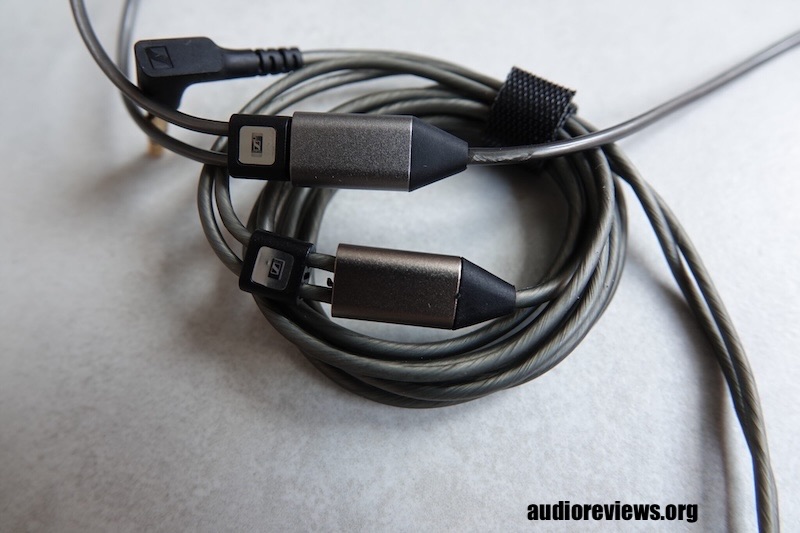
3) Genuine cable’s main sheath features a smooth, uniform, solid external finish. This fake unit’s sheath carries some sort of twisted wires appearance. You can appreciate this difference, too, from the picture above – where, again, the counterfeit cable is the coiled one, below the genuine one.
4) Assessing nozzle ends, genuine IE900 should look “pitch black”, while this counterfeit sample reveals silver colour inside through a wider mesh structure, as shown by this picture.
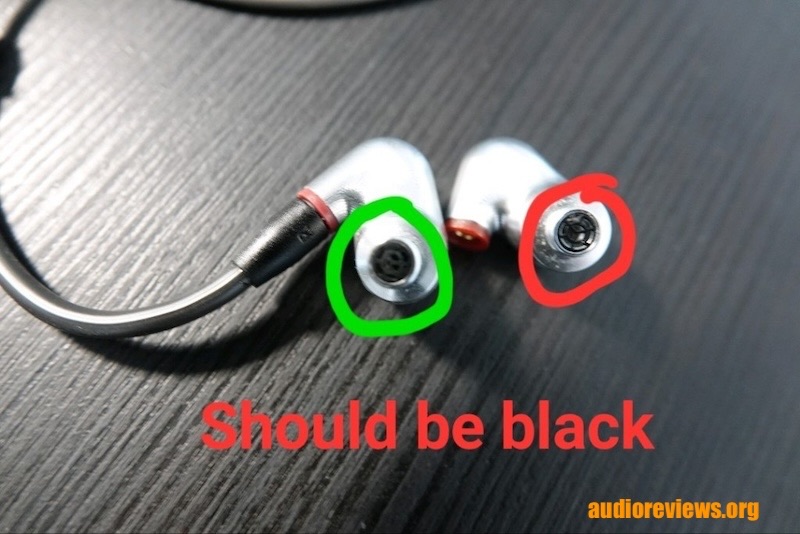
5) The pinned plastic plate carrying stock tips should show glossy S M L size letters, not matte ones. Furthermore, genuine foam tips have quite flat tops, not bulging ones. Based on this information, try yourself to spot the genuine set in the following picture 🙂 .
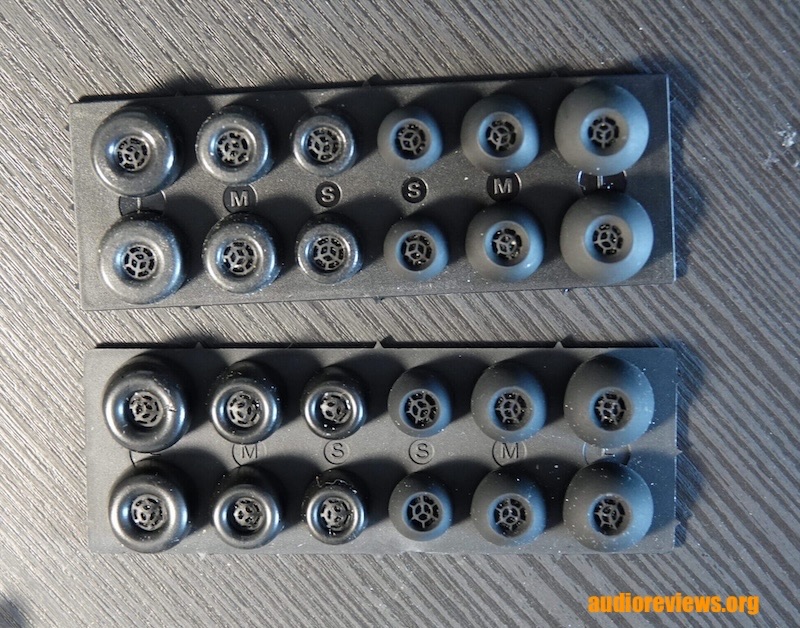
It’s of course worth noting that I could assess just one fake unit, so there is no certainty, let alone guarantee, that the above hints do apply to other cases.
Sennheiser recommends to buy new units exclusively from fully trusted, official Sennheiser distributors – and that’s a no brainer.
For second hand units – while of course remembering that channels like ebay or similar need to be taken with two grains of salt (always better than one) – a good idea is to have the seller send a picture showing the unit serial number in advance, and get in contact with Sennheiser Consumer Hearing support services: they will check if the number is reported as legit.
Considerations & conclusions
I tried to outline the multiple reasons why I believe IE900 are a beyond-outstanding product, particularly suitable for classical, and acoustic music in general, and I feel like adding some considerations at a more general level here.
What is seems from the outside is that Sennheiser did this by going back to the design board, and restart from assessing the wanted target, asking themselves how to reach it – “reinventing the wheel” if need be, and/or using more “usual” parts and competences, purging their minds from “assumed-well-established existing solutions” bias in advance.
Of course I have no real clue about their internal processes and how the real story went, but if it were a plot for a movie about an industrial success story, it might probably go as follows.
IE900’s dynamic driver itself is proprietary, made to deliver a sensibly wider range extension compared to other high quality dynamic drivers on the market. Why? Because multidrivers do struggle with tonal coherence – all of them – and, let’s face it, for good reasons too. On the other hand, existing single drivers are all “short blankets”, so to say.
So point #1 : let’s design a “wiiiiiide blanket” driver. Period. Then we see the rest.
Oh by the way: let’s do it without employing marketing-buzzword-level raw materials.
IE900’s is in the end a plastic membrane driver – such an “obsolete sounding” technology, inn’it? – yet it loops dozens of circles around others made of “newer materials”. Guess why?… 🙂 .
I must say I feel empathic on these topics as they can’t fail reminding me that within the infinitely more modest scope of the small industrial company I currently serve in as a marketing and sales manager I often listen to my agents recursively pointing at certain innovative-name-sounding products from the competition. Transeat. Back to our plot.
Once you have an eXtra Wide Range transducer, you are still supposed to shape its sound to manage its behaviour, avoid excesses, and bend its tonality to a specific wanted target sound. This is usually done by a mix of shaping IEM shells, adding vents, filters, foams, meshes etc.
As for us: we will primarily “shape the shells” – and good luck to those who will try to precisely copy them.
Inside IEx00 housings there are milled or built (depending on the specific model’s production process) micrometrically formed spaces (“chambers”). They even got as far as studying how wrinkled their internal surfaces need to be to get the right wanted effect on sound waves passing by.
I can only remotely fathom the complexity of such a research, and the level of competences, skills, tools and budgets (!) you need to put on the table to even commence spinning such a project up. Well they did it – and succeeded.
Last but not least: once you have those grand IEMs done, based on a superbly extended driver, and tuned to consistently output the exact wanted timbre and tonality onto… lab measuring equipment (!) how about maximising the chance the same or at least a very similar result is actually appreciated by anybody’s ears – which sadly (for engineers, and luckily for philosophers) are all “guaranteed different” from the most advanced acoustic coupler mockups employed at the lab ?
Yes, you can try closing the gap by filling the commercial package with countless alternative eartips, or…
Our mother company is a leading multinational involved in hearing aids and acoustic implantations. Let’s roll out a custom eartips program!
I presume this very long stream of considerations, and their fictionalized dressings, can be summarised as follows: the old saying “when the game gets tough, the tough get playing” is of course in general an abstraction – it does take for the tough to actually be willing to get playing ! But when they do… 😉 .
Sennheiser for decades did deliver undisputed top-class headphone models (do we need to remember that HD600 originally came out in 1997?) yet they flew much lower in the rankings of IEM proposals until recently.
With their IE900 / IE600 / IE200 program they took a wholly-renovated approach to the segment, and results do show.
These 3 models lead their corresponding price brackets, and debating whether they deserve #1, #2 or #3 entry in their specific subclasses is surely very important for Sennheiser’s product marketing, their numbers etc, but for us, the users, it’s now probably just funny, loud coffee bar discussions. IE200, IE600 and IE900 are, all of them, absolute winners, and each one can easily be taken as the sole IEM one may want to own given that budget and/or that musical preference.
IE900 are light years far from being yet-another high quality high priced single DD IEMs. They can and should be narrated as a successful reinvention of the entire IEM experience, instanced onto the specific preferences of classical and other acoustic music lovers.
Sennheiser created a monumental product with IE900, and while its price tag is no doubt demanding, not a cent of it lacks justification in the multifaceted quality it offers.
IE900 is dutifully tagged on our Wall of Excellence.
Our generic standard disclaimer.



